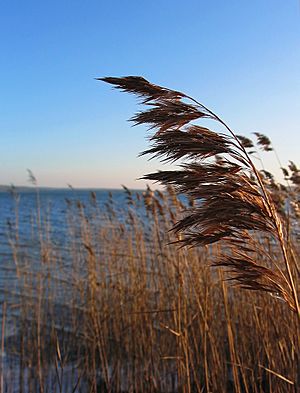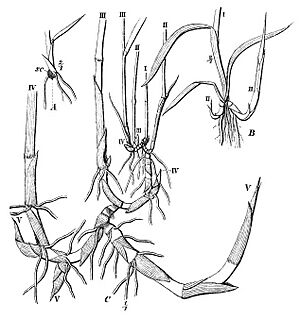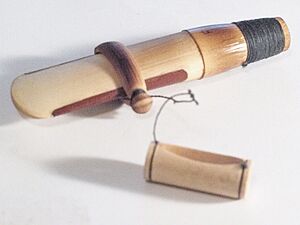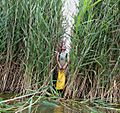Phragmites facts for kids
Quick facts for kids Phragmites |
|
|---|---|
 |
|
| Phragmites australis seed head in winter | |
| Scientific classification |
|
| Kingdom: | Plantae |
| Clade: | Tracheophytes |
| Clade: | Angiosperms |
| Clade: | Monocots |
| Clade: | Commelinids |
| Order: | Poales |
| Family: | Poaceae |
| Subfamily: | Arundinoideae |
| Tribe: | Molinieae |
| Subtribe: | Moliniinae |
| Genus: | Phragmites Adans. |
| Synonyms | |
|
|
Phragmites (say "frag-MY-tees") is a group of four types of large reed grasses. These plants grow in wetlands all over the world. They are found in both cool and warm areas. Phragmites plants are perennial, meaning they live for more than two years.
Contents
Discovering Phragmites Species
The Kew Gardens in London keeps a list of all known plant families. They recognize four main types of Phragmites species:
- Phragmites australis – This type is found almost everywhere in the world.
- Phragmites japonicus – This one grows in Japan, Korea, and parts of Russia.
- Phragmites karka – You can find this species in warm parts of Africa, Asia, and Australia. It has also spread to New Zealand.
- Phragmites mauritianus – This type grows in central and southern Africa, Madagascar, and Mauritius.
The most common type of reed is Phragmites australis. It has many other names, but Phragmites australis is the one scientists use most often.
Wildlife Living in Reed Beds
Reed beds are areas where many reeds grow together. These areas are very important for wildlife and nature. Many animals, especially birds, rely on large groups of Phragmites plants.
Birds That Love Reed Beds
In Europe and Asia, several bird species live mainly in these reed beds. They use the reeds for shelter and food. Some of these birds include:
- Bearded reedling (Panurus biarmicus)
- Reed warbler (Acrocephalus scirpaceus)
- Great bittern (Botaurus stellaris)
In Australia, reed beds also provide safe places for birds like grassbirds, reed warblers, crakes, and bitterns.
How People Use Phragmites
Phragmites plants have many different uses around the world.
Growing Phragmites as an Ornamental Plant
P. australis can be grown as a decorative plant. People plant it near ponds and lakes. However, it grows very fast and can spread quickly. So, it needs to be planted carefully.
Cleaning Water with Phragmites
Phragmites australis is one of the main plants used to clean water. This process is called phytoremediation.
Here is how it works:
- Dirty water, like from sinks or toilets, goes into a special tank.
- Then, the water flows through an artificial reed bed.
- Bacteria on the roots and leaves of the reeds help remove bad stuff from the water.
- After this, the water is clean enough to use for watering plants or to go back into nature.
Thatching Roofs with Reed
Reed is often used to make roofs. This is called thatching. In the British Isles, Phragmites used for this is known as Norfolk reed. Other materials, like wheat straw, are also used for thatching.
Making Music with Reed
In the Middle East, Phragmites is used to make a small instrument called a sipsi. It sounds a bit like a clarinet.
The reed for a zurna (another instrument) is also made from common reed. It is flattened and softened to create a vibrating part that makes sound.
Eating Parts of Phragmites
Many parts of Phragmites are safe to eat.
- Young shoots can be cooked or eaten raw, like bamboo shoots.
- Young stems can be dried, ground into a powder, and then roasted.
- The seeds and roots can be ground into flour or made into a thick soup called gruel.
- In Japan, young leaves are dried and mixed with flour to make dumplings.
Animals like cows, horses, and sheep can eat Phragmites. This helps control the plant's growth and provides useful products for people.
Traditional Medicine Uses
The roots of reeds have been used in traditional Chinese medicine. They were used to treat problems with breathing, like coughs and fevers. People believed that a drink made from reed roots could help reduce fever and restore body fluids.
Other Creative Uses
Phragmites australis and other reeds have many other uses:
- They can be woven into baskets and mats.
- They are used to make reed pen tips for writing.
- They can even be used to make paper.
- Beekeepers sometimes use reeds to make nests for bees.
In the Philippines, Phragmites is called tambo. The flowers are gathered in December and tied together to make whisk brooms. These brooms are commonly known as walis tambo. Reeds have also been used to make arrows and spears for hunting.
Controlling Invasive Phragmites
Some types of Phragmites can spread very quickly. When they are brought to new places, they can become an invasive species.
Why Phragmites Can Be a Problem
Before 1910, only a few areas in the United States had non-native Phragmites australis. But by 1960, it was found across the country. In some places, it has become the main type of plant.
Invasive Phragmites can cause problems:
- They grow very tall and thick, blocking sunlight for other native plants.
- They release chemicals that stop other plant seeds from growing.
- They take away food and space from native fish and wildlife.
- They can block access to water for swimming and fishing.
- They can also increase the risk of fires.
How to Manage Phragmites Growth
It is much easier to remove non-native Phragmites when it first starts to grow. Once it has spread widely, removing it by hand is very difficult. Even small pieces of roots or seeds can grow into new plants.
One common way to control Phragmites is to use special plant-killing liquids (herbicides) that are safe for water. After applying the liquid, the dead plants are often burned. This helps stop them from growing back.
However, using too much herbicide at once can cause problems. A lot of dead plant material can reduce the oxygen in the water, which can harm fish. So, in smaller ponds, it is best to treat only a small part of the reed bed at a time.
Other methods that have shown some success include:
- Letting goats eat the Phragmites.
- Doing controlled burns of the plants.
- Planting native wild rice crops to compete with the reeds.
Gallery
-
Phragmites in Amsterdam, Netherlands
-
Phragmites australis in the Great Lakes
See also
 In Spanish: Phragmites para niños
In Spanish: Phragmites para niños









